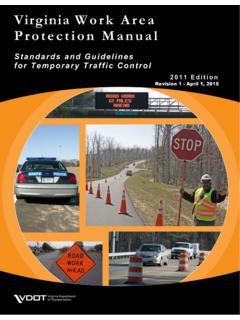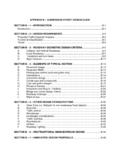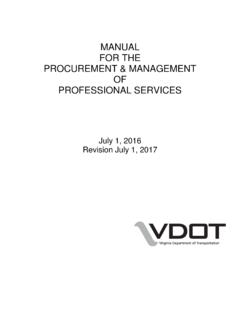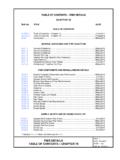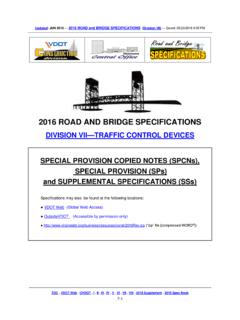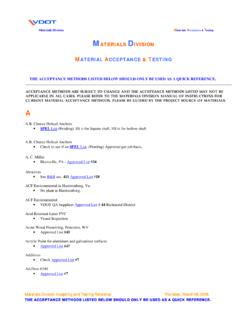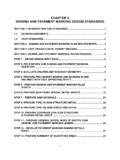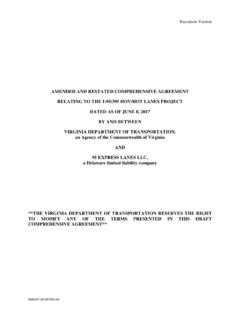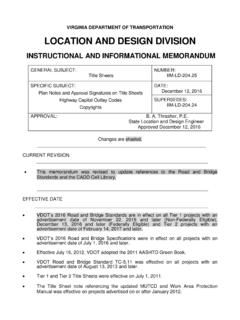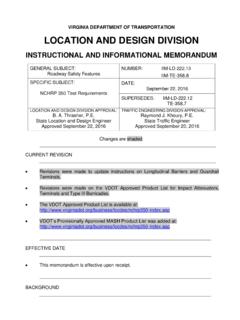Transcription of Virginia Department of Transportation Rural Rustic …
1 Virginia Department of Transportation Rural Rustic road Program manual Administered by the Virginia Department of Transportation Local Assistance Division 2014 For further information, contact your local Residency Administrator, or Local Assistance Division Virginia Department of Transportation 1401 East Broad Street Richmond, Virginia 23219 (804) 786-2746 Table of Contents Background ..1 Rural Rustic road Concept ..1 Program Eligibility Criteria ..2 Planning and Approval Process ..3 Environmental and Hydraulic Requirements ..3 List of Appendices Appendix Environmental and Hydraulic Requirements Checklist ..I Rural Rustic road Program Project Scoping Report ..II Sample Board of Supervisors Resolution ..III Rural Rustic road Program Legislation ..IV Comparison of Unpaved road Improvement 1 Background The Rural Rustic road concept, first enacted by the 2002 Session of the General Assembly of Virginia , is a practical approach to paving Virginia 's low volume unpaved roads.
2 A pilot program, implemented in July 2002, demonstrated the success of this concept. It ensures that VDOT practices environmental and financial stewardship while providing basic paved access to more of Virginia s Rural countryside. The 2003 Session of the General Assembly amended the legislation to provide that this method be considered as a first alternative for improving all unpaved roads in the future. The Rural Rustic road Program, under (previously ) of the Code of Virginia , became effective July 1, 2003. The Virginia Department of Transportation s Local Assistance Division working with the Rural Rustic road Policy Committee established the initial guidelines for this program. The Local Assistance Division, in consultation with the Location and Design Division, has periodically updated the guidelines to reflect legislative revisions to the program. During the 2006 Session, and again during the 2008 Session, the General Assembly expanded the program by increasing the maximum traffic count on eligible roads from the initial 500 vehicles per day (VPD) to the current 1,500 VPD.
3 In addition, during its 2008 Session, the General Assembly established that the maximum speed limit for a road designated as a Rural Rustic road , on or after July, 1 2008, is 35 MPH. The Commissioner of Highways is authorized under of the Code of Virginia to increase, or decrease, this speed limit based on an engineering study. The 2011 General Assembly Session amended the legislation to provide additional flexibility regarding Virginia Stormwater Management Program regulations for Rural Rustic road projects that meet certain criteria. This legislation provided that Rural Rustic road projects placing a hard surface along the same basic alignment as the prior gravel impervious area with accompanying shoulder and drainage work are treated as routine maintenance activities for the purpose of VSMP regulations. In 2013, the Commissioner of Highways signed VDOT Department Memorandum DM 13-2 for the Administration of the Unpaved road Program.
4 This revision of the Rural Rustic road Program manual incorporates changes and provides additional clarifications associated with the new Unpaved road Program DM. Rural Rustic road Concept Fundamentally, the Rural Rustic road concept is the paving of an existing unpaved road with a compacted or impervious surface and reestablishment of existing associated ditches and shoulders, and usually the new hard-surfaced road is on the same horizontal and vertical alignment as the prior gravel impervious area. Furthermore, a focal point of the program is on leaving trees, vegetation, side slopes, and open drainage abutting the roadway, undisturbed to the maximum extent possible. Improvements along a Rural Rustic road project may be less than minimum design standards. AASHTO s Guidelines for Geometric Design of Very Low-Volume Local Roads (ADT 400) may be used as a guide for roads with current traffic volumes up to 400 VPD.
5 For roads with traffic volumes between 400 and 1,500 VPD, an 18-foot paved surface with 2-foot shoulders is 2 desirable, but not required. The District Location and Design Engineer will be consulted for the higher volume roads (over 400 VPD). The ideal Rural Rustic road project usually involves reshaping of the roadbed, cleaning ditches and applying a hard surface within existing right of way. In most cases, it is assumed there are no actual construction plans and therefore, few occasions when a Rural Rustic road project would require an engineered solution. The Rural Rustic road concept may still be used to address more significant needed improvements if deemed appropriate. However, improvements beyond those required to address specific safety issues should be weighed against their probable cost. In lieu of more costly improvements, consideration should be given to the use of appropriate warning signs as needed recognizing the program goals of minimal disturbance and providing hard surfacing at the lowest possible cost.
6 Typical examples of when engineered solutions may be required on Rural Rustic roads are when alignment improvements are needed to address identified safety issues, or improvements are needed to address severe drainage and/or erosion issues. Engineered solutions should be noted on the Scoping Report (Appendix II) and will usually trigger additional requirements typical of traditional construction projects such as the requirement to have plans signed and sealed by a Professional Engineer in accordance with the Department s IIM-LD-243, as well as those requirements further detailed under the Environmental and Hydraulic Requirements. The L&D Engineer will sign the scoping report when an engineered solution is required. Program Eligibility Criteria The following criteria are those by which a candidate road is evaluated to determine its eligibility for hard-surfacing under the Rural Rustic road Program.
7 The road : Must be an unpaved road already within the State Secondary System. Must carry no more than 1,500 VPD. Must be a priority (line item) in the locality s approved Secondary Six-Year Plan (SSYP) if the funding source is from secondary system allocations. If secondary system allocations are not used, the project is not required to be in the SSYP. However, the applicable provisions for public involvement must be met. Must be used predominately for local traffic. The local nature of the road means that most motorists using the road have traveled it before and are familiar with its features. Must have minimal anticipated traffic growth. The County Board of Supervisors will endeavor to limit growth on roads improved under the Rural Rustic road Program, and cooperate with VDOT through its comprehensive planning process to develop adjacent lands consistent with Rural Rustic road concepts.
8 3 In addition, the Board of Supervisors, by resolution, must designate the road as a Rural Rustic road . Planning and Approval Process The Residency Administrator, as described herein, is the Department s local liaison responsible for dealing with a County s Board of Supervisors regarding Rural Rustic Roads. The District Administrator may designate another local contact to serve as the coordinator with the local government. A candidate project is initiated when the Board of Supervisors requests the Residency Administrator to evaluate a section of road for the Rural Rustic road Program or when the Residency Administrator reviews a new proposed unpaved road project in the locality s approved SSYP for eligibility as a Rural Rustic road project. The comparison of unpaved road improvement options is Appendix VI of this manual . The Residency Administrator will consult with other technical experts as deemed appropriate to evaluate the roadway.
9 Following evaluation, the Residency Administrator advises the Board of Supervisors whether the unpaved road can be hard-surfaced through the Rural Rustic road Program. If the road is not eligible, the Board of Supervisors may appeal the decision through the Residency Administrator to the District Administrator, and ultimately the Chief Engineer for consideration by the Commissioner of Highways. The Board of Supervisors, by resolution, designates the road as a Rural Rustic road . A sample resolution is Appendix III of this manual . The Residency Administrator notifies the District Administrator and the Regional Operations Director, that the road has been designated as a Rural Rustic road . The Regional Operations Director, at the request of the Residency Administrator, may conduct a traffic engineering study to evaluate the road for a posted speed limit, or post the road at the 35 MPH maximum established in of the Code of Virginia .
10 The Residency Administrator conducts a scoping meeting, as appropriate, and completes the Rural Rustic road Program Project Scoping Report (Appendix II). An exemption has been provided for this program to utilize this scoping report instead of the traditional scoping report (PM-100). Environmental and Hydraulic Requirements Due to the nature of the projects developed under the Rural Rustic road Program, they may be exempt from many environmental and stormwater related requirements and/or permits associated with typical construction projects. The Residency Environmental Specialist or District 4 Environmental staff (Items 1 6) and the District Hydraulics Section (Items 7 9) will be required to evaluate each project and, using the checklist in Appendix I, document whether or not the project qualifies for an exemption from each requirement category. The completed checklist, along with any supporting documentation, will become a part of the project s file.
